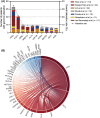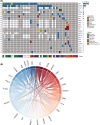Genomic landscape and preclinical models of angiosarcoma
- PMID: 39367667
- PMCID: PMC11977660
- DOI: 10.1002/1878-0261.13744
Genomic landscape and preclinical models of angiosarcoma
Abstract
Angiosarcoma is a cancer that develops in blood or lymphatic vessels that presents a significant clinical challenge due to its rarity and aggressive features. Clinical outcomes have not improved in decades, highlighting a need for innovative therapeutic strategies to treat the disease. Genetically, angiosarcomas exhibit high heterogeneity and complexity with many recurrent mutations. However, recent studies have identified some common features within anatomic and molecular subgroups. To identify potential therapeutic vulnerabilities, it is essential to understand and integrate the mutational landscape of angiosarcoma with the models that exist to study the disease. In this review, we will summarize the insights gained from reported genomic alterations in molecular and anatomic subtypes of angiosarcoma, discuss several potential actionable targets, and highlight the preclinical disease models available in the field.
Keywords: angiosarcoma; genomics; rare cancer; sarcoma.
© 2024 The Author(s). Molecular Oncology published by John Wiley & Sons Ltd on behalf of Federation of European Biochemical Societies.
Conflict of interest statement
The authors declare no conflict of interest.
Figures




References
-
- Fury MG, Antonescu CR, Van Zee KJ, Brennan MF, Maki RG. A 14‐year retrospective review of angiosarcoma: clinical characteristics, prognostic factors, and treatment outcomes with surgery and chemotherapy. Cancer J. 2005;11(3):241–247. - PubMed
-
- Rosenbaum E, Antonescu CR, Smith S, Bradic M, Kashani D, Richards AL, et al. Clinical, genomic, and transcriptomic correlates of response to immune checkpoint blockade‐based therapy in a cohort of patients with angiosarcoma treated at a single center. J Immunother Cancer. 2022;10(4):e004149. - PMC - PubMed
-
- Florou V, Wilky BA. Current and future directions for angiosarcoma therapy. Curr Treat Options Oncol. 2018;19(3):14. - PubMed
Publication types
MeSH terms
Grants and funding
LinkOut - more resources
Full Text Sources

